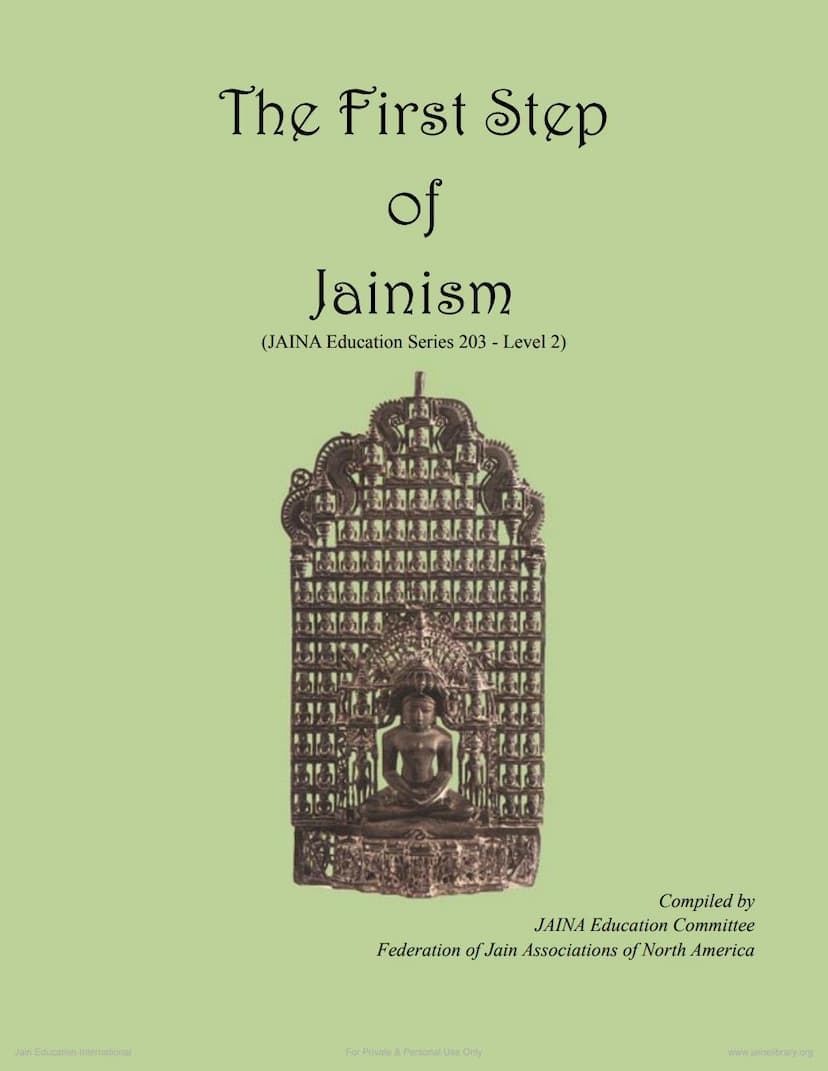JES 203 First Step Of Jainism Level 2 Book
Added to library: September 1, 2025
Loading image...

Summary
This document is a comprehensive educational resource on Jainism, titled "The First Step of Jainism - JES 203 (JAINA Education Series 203 - Level 2)". Published by the JAINA Education Committee, it aims to introduce the fundamental principles and practices of Jainism to a young audience, particularly in English-speaking countries.
Key aspects covered in the book include:
- Introduction to Jainism: Jainism is presented as one of India's oldest living religions, emphasizing scientific principles and universal truths. It highlights its core tenets of Ahimsä (non-violence), Anekäntaväda (non-absolutism), and Aparigraha (non-possessiveness) as pathways to peace and harmony.
- JAINA Education Series: The book is part of a broader educational initiative by JAINA (Federation of Jain Associations in North America) to make Jain principles accessible through various media and age levels.
- Core Jain Beliefs and Practices:
- Stutis (Prayers): Includes the Namaskar Mantra, Kshamäpana Sutra (forgiveness), Ärati (worship with lamps), and a prayer for infinity.
- Basics of Jainism: Explains Jainism as a "Way of Life," the concept of Jinas (victors over passions), Tirthankars (spiritual guides), the nature of the soul (Ätmä), Karma theory, and the distinction between living (Jiva) and non-living (Ajiva) beings.
- Five Venerable Personalities (Pancha Paramesthis): Details the roles and significance of Arihantas, Siddhas, Acharyas, Upadhyäys, and Sädhus/Sädhvis.
- Tirthankars: Explains the role of Tirthankars, their life events (Kalyanaks), the Samavasaran (sermon hall), and their distinguishing symbols (Länchhans).
- Jain Temple: Discusses the purpose and etiquette of visiting a Jain temple.
- Swastika (Säthiyä): Explains the symbolism of the Swastika, representing the four states of existence (Gatis), and the three jewels of Jainism (Samyak Darshan, Samyak Jnän, Samyak Chäritra).
- Soul (Ätmä): Describes the soul's inherent qualities of infinite knowledge, perception, bliss, and energy.
- Karma: Elaborates on the law of cause and effect, the types of Karma (Ghäti and Aghäti), and how Kashäyas (passions) bind Karma.
- Dos and Don'ts: Provides simple guidelines for conduct, emphasizing virtues like respect, kindness, honesty, and forgiveness.
- Life of Bhagawan Mahävir: Chronicles the life of the 24th Tirthankar, including his previous lives, birth, childhood (demonstrating courage and strength), renunciation, austerities, attainment of Keval-jnän (omniscience), preachings, and Nirvana (liberation).
- Jain Festivals: Describes major festivals like Mahävir Jayanti, Paryushan/Dash Lakshana (focusing on forgiveness and virtues), and Diwali (symbolizing light and knowledge).
- Living Values: Explores key virtues and vices through stories and examples:
- Anger/Forgiveness: Emphasizes controlling anger and practicing forgiveness.
- Ego/Humility: Highlights the vice of ego and the virtue of humility, illustrated by stories of the Hare and Tortoise, and Bähubali.
- Deceit/Honesty: Stresses the importance of truthfulness and integrity.
- Greed/Contentment: Discusses the pitfalls of greed and the peace found in contentment.
- Compassion: Encourages empathy and kindness towards all living beings.
- Friendship: Explores the value of true friendship.
- Perseverance: Motivates readers to remain persistent in achieving their goals.
- Self-Reliance: Promotes independence and the ability to overcome challenges.
- Jainism in Action:
- Conscious Consumer: Guides readers to make ethical choices regarding products, avoiding animal exploitation (meat, dairy, leather, silk, pearls, Varakh).
- Environment: Underscores Jainism's ecological principles, emphasizing respect for nature, non-violence towards all life forms, and the concept of interdependence.
- Nutrition, Health, and Spirituality: Connects a balanced, cruelty-free diet with spiritual well-being and physical health.
- Yoga, Health, and Spirituality: Introduces yoga as a path to self-control, physical health, mental clarity, and spiritual progress, detailing various yoga postures.
- Glossary: Provides definitions for key Jain terms used throughout the book.
The book's overall tone is educational and encouraging, aiming to instill Jain values and promote a compassionate and ethical lifestyle in young learners. It uses stories, rhymes, and clear explanations to make complex concepts accessible.